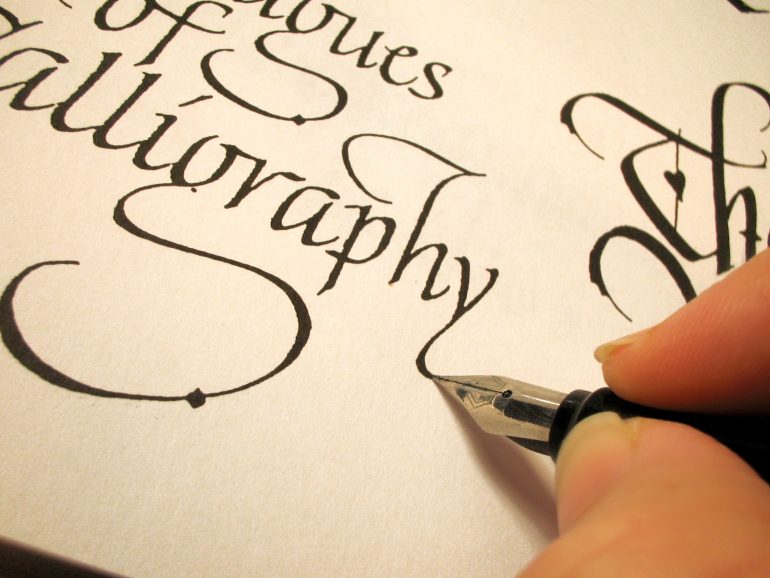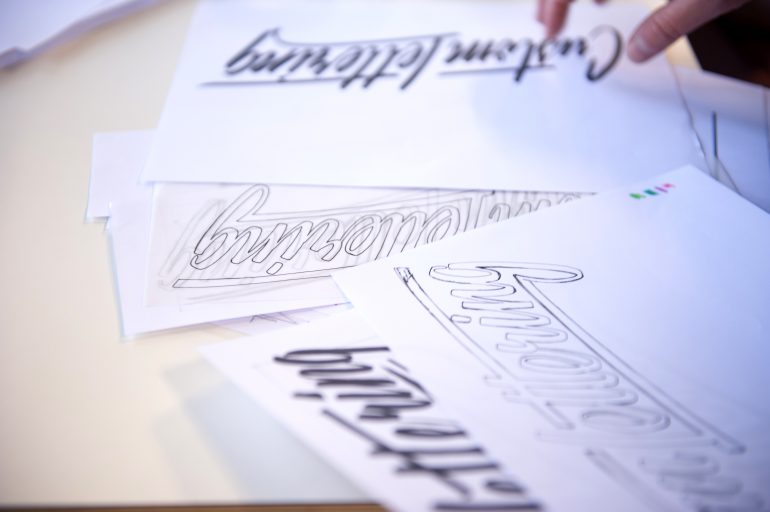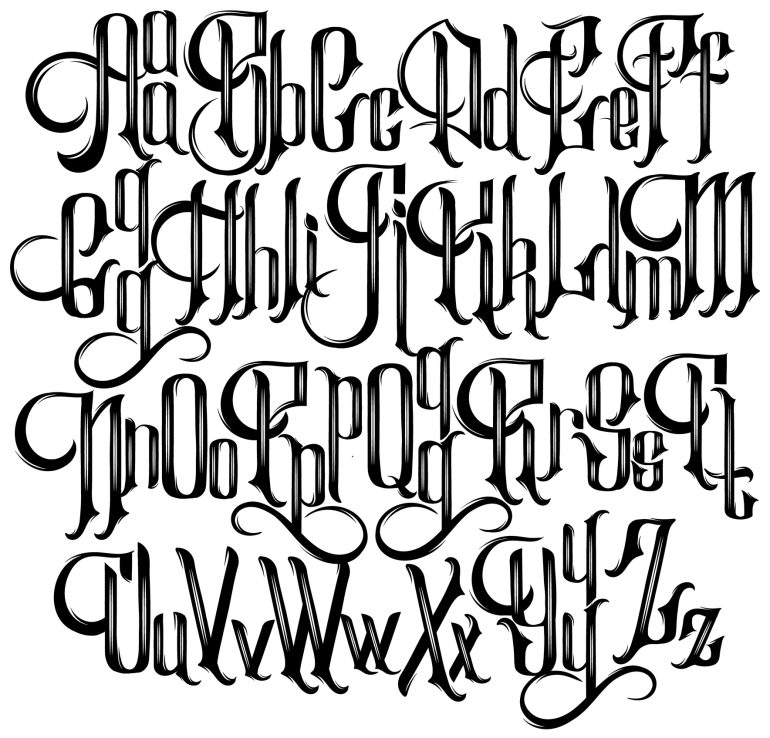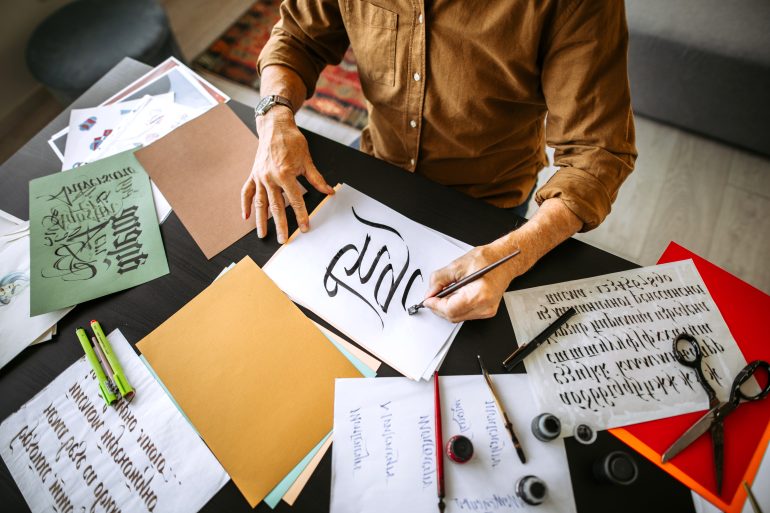Whether you’re a DIY enthusiast yearning to add a personal flair to your creations, an art lover looking for a new medium of expression, or just someone drawn to the symphony of ink on paper, this guide to how to start calligraphy at home is your portal to the world of elegant curves and stylish strokes.
As you embark on your path to perfect penmanship, it’s wise to remember that behind every nib stroke lies not just ink, but a piece of unique creative spirit. So, let’s unfold the mystery of beautiful writing and let your creativity flow free in this guide to how to get started with calligraphy.
What Is Calligraphy?

Writing in calligraphy letter form. (Credit: gvictoria via Getty Images)
Calligraphy is a visual art that centres on writing design. It’s a unique practice of creating expressive, harmonious, and skillful lettering with a broad-tipped instrument, brush, or other writing equipment.
Traditionally, calligraphers pay great attention to the rhythmic, structured, and aesthetic aspects of each character or symbol they pen, creating not just readable text, but also a visually pleasing piece of art.
Most likely derived from the Greek words ‘kallos’ meaning ‘beauty’ and ‘graphein’ meaning ‘to write’, calligraphy is literally the art of beautiful writing.
The roots of calligraphy don’t hail from a specific time and place. Most ancient cultures used different styles of beautiful writing. From the stunning seventh century Islamic calligraphy in the Middle East, illuminated manuscripts from western Europe in the Middle Ages, and ancient Greek, Japanese, Chinese and Indian writings as well as Egyptian hieroglyphics, calligraphy in one form or another has been with us for thousands of years.
Start at the Very Beginning

Some hand lettering calligraphic sketches created without specialist calligraphy pens. (Credit: Lucy Lambriex via Getty Images)
Faux calligraphy, also known as “fake” calligraphy, is a technique of imitating traditional calligraphy without the need for specialised calligraphy tools such as broad-tipped pens, brushes or quills. Instead, it can be accomplished using regular pens, pencils or even digital tools.
The process typically involves writing letters or words in standard script, then thickening or doubling the downstrokes, which are the lines drawn in a downward direction, to create the illusion of the characteristic thick and thin lines of traditional calligraphy.
Faux calligraphy is a popular method for beginners who are interested in how to start learning calligraphy, as it offers a simpler entry point to understanding letter structures and line variations without requiring mastery of complex tools and inks.
All you need is a pencil and pen, some paper, a rubber, and a ruler. Faux calligraphy is an excellent way to learn the shapes and styles of calligraphic letters before diving into more advanced tools and techniques. Plus, it allows you to make mistakes and correct them more easily.
If you want to know how to learn calligraphy step by step, here’s a quick guide to faux calligraphy:
- Write out a word or phrase in a cursive script (one that mimics lower-case handwriting) or indeed any other stylised script using a regular pen, pencil or marker.
- Identify which strokes are the downstrokes. These are the parts of your letters where you pull the pen towards you or straight downward on the page.
- Draw a parallel line to the downstrokes on one side, creating an empty space, known as a gap.
- Then, you need to fill in the gaps which will give the illusion of a thick downstroke.
These are the fundamentals of how to start learning calligraphy.
How to Get Started with Calligraphy - Supplies & Scripts

Handwritten Gothic font (Credit: KatyTutynina via Getty Images)
If you’re captivated by calligraphy, you’re going to need some supplies and you’ll want to research the types of scripts you’d like to learn.
If you want to progress to the next level, you’ll need brush pens, nibs, inks and good quality paper. The quality and range of supplies available will vary – you can spend a little or you can spend a lot, so determine your budget and spend accordingly.
Choosing the scripts you want to learn is also a good idea if you’re wondering how to get started with calligraphy. Calligraphy has a rich history and as a result, a wide variety of scripts or styles have developed. These include scripts such as Copperplate, Spencerian, Gothic, Uncial, Italic, and many more. Each script has its own character, rules, and nuances. By choosing a couple of scripts you’re particularly drawn to, you can focus your practice and deepen your understanding.
Personal Preference Choose a script or scripts that you find visually appealing. You’ll be more motivated to practise if you enjoy the look of the script.
Pick a Purpose Different scripts suit different purposes. For example, Copperplate or Spencerian are often used for formal invitations and certificates, whereas modern calligraphy, which is less rigid, is popular for casual event stationery and wall art.
Difficulty Some scripts are easier to learn than others. For instance, Italic script is often recommended for beginners due to its relatively straightforward letterforms and less stringent rules. To discover how to start calligraphy at home, pick an easy script and you can always up your game at a later stage.
Tools Different scripts require different pens, nibs and inks. If you already have certain tools at hand, or if there’s a specific tool you wish to master (like a broad edge pen or a pointed pen), let that guide your script choice.
Over the course of your calligraphy journey, you might branch out and learn other scripts, but having a solid foundation in one or two styles can boost your confidence and skills in calligraphy overall.
The Calligraphy Community

A calligraphy workshop with various calligraphic pens and tools. (Credit: Westend61 via Getty Images)
The irony of calligraphy being a throwback to a classic, traditional artform isn’t lost when we suggest that one of the best places to discover how to start learning calligraphy is online!
If you do want to know how to learn calligraphy step by step, this is a great way to get involved. There are also calligraphy-focused social communities, forums, websites, and you may find local classes or workshops. These are especially useful for those who prefer more direct methods of learning.
The Creative Call of Calligraphy

Artist writing calligraphy letters on different paper (Credit: hobo_018 via Getty Images)
Mastering the art of calligraphy is a journey that marries patience with practice. As you explore different scripts, experiment with various tools, and embrace the joy of creating beautiful letters, remember that every stroke brings you closer to expressing your unique creative vision.
In this digital age, understanding how to start calligraphy allows us to preserve a touch of personal expression, an echo of individual style. Whether you aspire to create elegant event invitations, stunning wall art, or simply enjoy the meditative process of ink meeting paper, your calligraphy journey begins with that first stroke. So pick up your pen, let the ink flow, and let the world become your canvas.












